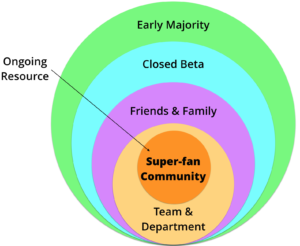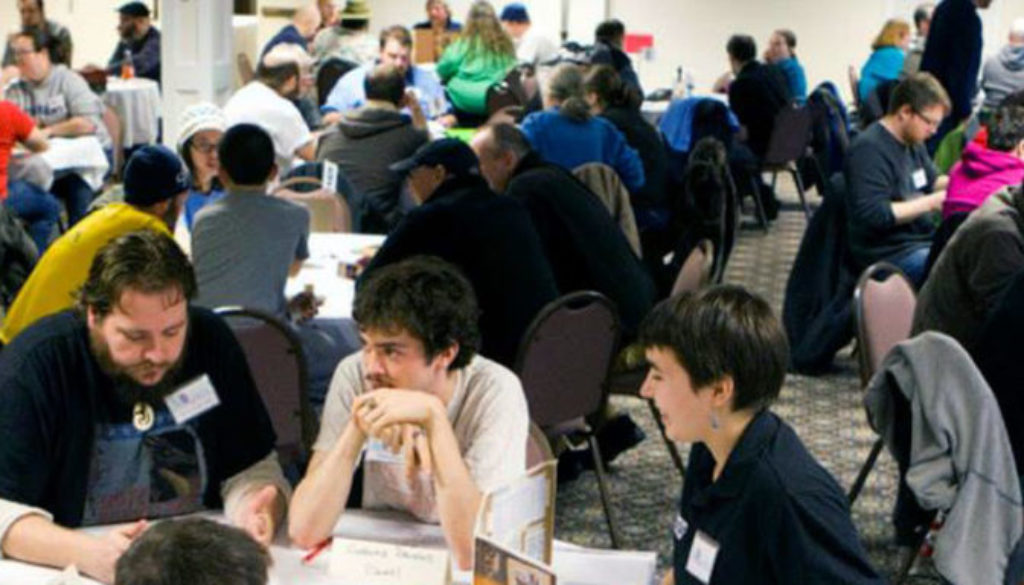What’s the missing ingredient in your lean product strategy?
If you’re creating games, products, apps or services and embrace a lean/agile mindset. you already know that developing and play-testing your idea with potential customers is pivotal to your success.
But here’s the thing: it’s not always clear exactly WHO you should be testing your ideas on, as you’re bringing your product to life. Which customers should you solicit feedback from early-on? What about validating ideas – who should you pay attention to when there’s conflicting feedback? And as you get closer to launch, how should your play-testing strategy change?
Concentric Rings of Play-testing
 Most product creators start out by testing their ideas, sketches and prototypes with a small, trusted circle of people – e.g. the team and department that’s building the product – to bring the basics to life and get early feedback. Next, they’ll open it up to a broader circle – such as friends and family, or a limited closed Beta test. After that, they’ll focus on connecting with their ideal customers – their Early Majority – as they launch and expand their product.
Most product creators start out by testing their ideas, sketches and prototypes with a small, trusted circle of people – e.g. the team and department that’s building the product – to bring the basics to life and get early feedback. Next, they’ll open it up to a broader circle – such as friends and family, or a limited closed Beta test. After that, they’ll focus on connecting with their ideal customers – their Early Majority – as they launch and expand their product.
These Concentric Rings of play-testing are common in product and game development – and many products are launched this way. But there’s something missing in this progression – something that’s common to the most successful innovators – the ones that produce breakthrough hits like eBay, Ultima Online, the Sims, Rock Band, Happify, Covet Fashion and Slack.
This missing ingredient can be your secret weapon – a powerful resource that informs your design and super-charges your product development. IF you manage it right.
Build & Leverage a Superfan Community
 The secret ingredient behind so many innovative hits is a Super-fan Community – a small group of vetted, high-need early customers who provide ongoing input, and help bring the product to life. Smart product creators engage these people early in development – and continue to leverage their input and energy throughout development.
The secret ingredient behind so many innovative hits is a Super-fan Community – a small group of vetted, high-need early customers who provide ongoing input, and help bring the product to life. Smart product creators engage these people early in development – and continue to leverage their input and energy throughout development.
Your super-fans are NOT your “target market”- they’re a higher-need and further-ahead slice. Think of them as a proxy for where your “early majority” might be in a few months or years.
We know from Innovation Diffusion Theory — and it’s well-known descendent. Crossing the Chasm – that innovators NEED to find and delight their early-adopter market before trying to win over the early majority. The startup graveyard is littered with companies who’s tried to skip over that step – and failed.
Successful innovators understand that they need to work with their Super-fans early in development — and then shift towards understanding the mainstream players later, during launch and expansion. They add “super-fans” to their Concentric Rings play-tesitng plan, as shown here — and then leverage that resource to super-charge their path to product/market fit.
Key Ingredients for your Superfan Community
To harness the power of your early passionate customers to build a better product, try inviting them into a small, focused group where you talk with them, learn from them — and listen to them talking with each other. If you want to build a high-value super-fan community that will enhance your product development, you’ll need three key ingredients:
- vetted super-fans – AKA high-value, high-need early customers
- group gathering place – using a tool that your super-fans are comfortable with
- lightweight community management – based on the Lead/Listen/Learn framework
Intrigued? Come to our FREE Webinar this Tuesday October 25 at 9 AM PST
Build your Super-fan Community: 5 Key Questions that reveal your ideal customers.
During this training, you’ll learn how to find the right super-fans, select a convenient group gathering place, and run a lively and focused community that keeps your super-fans engaged – AND provides ongoing high-value feedback to your development team.
To learn more and signup for this FREE Webinar, CLICK HERE. Hope to see you at the event!

What’s the missing ingredient in your lean product strategy? - Gamification of Agile
October 23, 2016 @ 6:35 am
[…] post What’s the missing ingredient in your lean product strategy? appeared first on Amy Jo […]